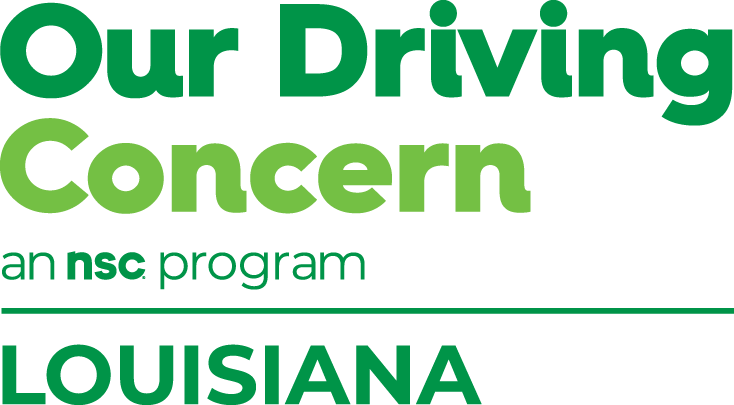Take the Lead
 During Alcohol Awareness Month in April, you have a unique opportunity to foster a culture of safety and accountability – on the road, at work and beyond – by amping up education and awareness around making responsible choices.
During Alcohol Awareness Month in April, you have a unique opportunity to foster a culture of safety and accountability – on the road, at work and beyond – by amping up education and awareness around making responsible choices.
Why it Matters
Alcohol misuse doesn’t just impact individuals, it can affect workplace productivity and safety, and raise questions regarding liability. Get alcohol-impaired driving facts from the National Safety Council. Know this:
- Nearly one-third of all U.S. traffic fatalities involve alcohol-impaired driving. According to the LSU Center for Analytics & Research in Transportation Safety data, 31% of motor vehicle crashes in Louisiana were alcohol-related in 2022 and 261 people were killed in alcohol-impaired crashes.
- More than half of drivers injured in crashes nationwide have alcohol or drugs in their system at the time of an incident, according to the Centers for Disease Control and Prevention.
- The annual economic cost of alcohol-related crashes in the U.S. exceeds $57 billion, according to the National Highway Traffic Safety Administration.
Now is the perfect time to remind employees about making safe choices, whether that means arranging for a designated driver, using ride-share services or knowing when to say no.
What Employers Can Do
Taking an active role in Alcohol Awareness Month can make a meaningful difference:
- Promote safe transportation options: Encourage employees to plan ahead for a sober ride home; consider partnering with local transportation services to offer discounted rides
- Raise awareness: Use internal communication channels to share statistics, safety reminders and personal stories about the impact of impaired driving
- Reinforce workplace policies: Review and communicate your organization’s stance on alcohol use, including any policies related to safety-sensitive positions
- Encourage a supportive environment: Provide resources for employees who may be struggling with alcohol misuse, including employee assistance programs
Boost Your Safety-related Efforts
Make use of these free resources to increase impact:
- Get marketing and communication materials from the Louisiana Highway Safety Commission to promote safe driving.
- Get free resources from the National Highway Traffic Safety Administration and work to eliminate drunk driving.
By taking proactive steps, employers can play a vital role in reducing alcohol-related incidents and keep employees, their families and members of the community safe. Let’s drive awareness and make responsible choices the norm.
Stress Check
 World Health Day, observed every year on April 7, is a reminder of the importance of physical and mental well-being. For employers, it’s an opportunity to focus on a critical but often overlooked aspect of workplace safety: the link between stress and impairment.
World Health Day, observed every year on April 7, is a reminder of the importance of physical and mental well-being. For employers, it’s an opportunity to focus on a critical but often overlooked aspect of workplace safety: the link between stress and impairment.
The Hidden Risk of Stress-impaired Workers
Stress is a health concern – and it’s a safety issue. When employees experience high levels of stress, their ability to focus, make decisions and respond quickly diminishes. This can lead to decreased productivity, increased workplace incidents and impaired driving risks for employees who operate vehicles as part of their job.
According to research, chronic stress can have similar effects on cognitive function as fatigue or substance use. In high-risk industries, this could mean the difference between a safe workday and a serious incident.
Employers Can Take Action
Creating a workplace culture that prioritizes mental health is a key step in reducing stress-related impairment.
Implement Workplace Impairment Training – A comprehensive approach to safety must address all forms of impairment, including stress-related impairment. Our Workplace Impairment Training program equips supervisors and safety leaders with tools to recognize impairment, intervene appropriately and support employees in need. Learn more about the training or contact us to schedule a session at your location.
Here are some additional ways safety leaders can make a difference:
- Acknowledge the impact of stress: Open conversations about stress and its effects can help reduce stigma and encourage employees to seek support
- Offer mental health resources: Providing access to employee assistance programs and stress management resources can improve overall wellbeing
- Stay informed: Get facts from the National Safety Council to support your impairment-related education and training efforts
- Encourage work-life balance: Promoting flexible schedules, regular breaks and wellness initiatives can help employees manage stress more effectively
Go the Distance
Commit to fostering a safer, healthier workplace. Prioritizing mental wellbeing not only enhances employee morale but also strengthens workplace safety by reducing the risk of incidents on and off the job.
